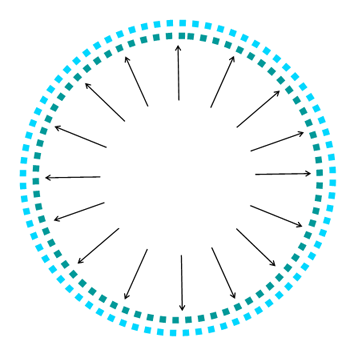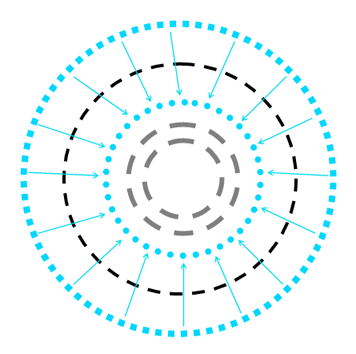09 | Groundwork | Four Observations: Origin
December 28th, 2011 by bruno boutotNote: The five posts entitled “Groundwork” were originally written in 2009. See here.
. #
Push models treat people as passive consumers whose needs can be anticipated and shaped by centralized decision-makers.
Pull models treat people as networked creators who are uniquely positioned to transform uncertainty from a problem into an opportunity.
John Hagel and John Seely Brown
From Push to Pull (pdf) #
figure 17: Sending printed media to consumers #
Observations on figure 17 #
For a print media, the content is printed on a support (the black squares in the inner circle); these supports are distributed (the black squares in the outer circle) to reach the users wherever they are (the blue squares), either by mail or via stores, newsstands, posters. #
The publisher of a printed media is the origin of the communication, which travels toward its readers. #
figure 18: Sending electronic media to consumers #
Observations on figure 18 #
For a radio or TV station, the content is sent out (broadcasted over the airwaves or through cables) to receiving devices (the green squares) near the users (the blue squares). #
Here the station is the origin of the communication, which travels toward the users. #
Whether for print or electronic media, users don’t need to know the specific place where the media is created: they are in contact with paper supports or receiving devices, not with the media makers. #
figure 19: Users going to a Web media #
Observations on figure 19
#
The black dashes stand for any media on the Web.
Media people put the content (the gray dashes) on their web sites.
They don’t send any printed object, they don’t send anything over the airwaves: the content just stays on a server.
The content of the media does not travel in space nor in time. #
The users (the blue squares) decide if they want to visit the media and to give their attention (the blue dots) to its content (the gray dashes).
The origin of the communication is the user. #
What origin changes?
#
On the Web, since we don’t have to send our content out in a tight package over space and time, we don’t have to create and present our content as a tight package anymore. #
A media is not a product anymore, it’s a place. #
Since people are coming to our place we are probably better to have a mindset, an infrastructure, and features to welcome them. #
#




